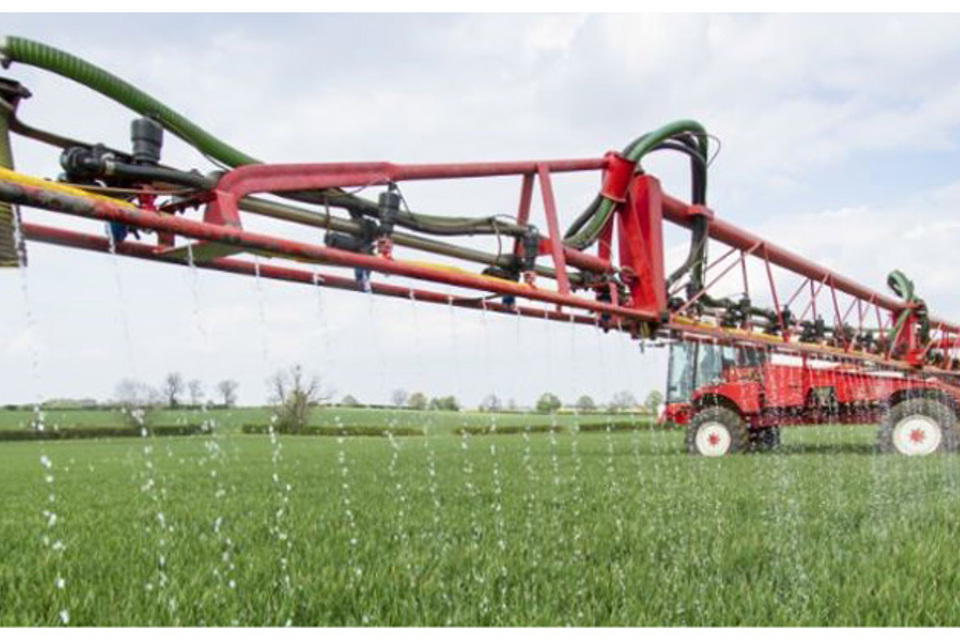
Taking the Liquid Approach
Case Study - 24.04.17
Devon growers make the most of liquid fertiliser
Liquid fertilisation is becoming increasingly popular with West Country farmers – with two growers in North Devon, David Down and Steve May, demonstrating its benefits.
Based at Hayne Farm, near Barnstaple, David has relied on liquid fertilisers for a good 20 years across his farming business, which now extends to around 1,000ha of crops and grass.
Steve, on the other hand, is just starting to use liquid fertilisers at New Cross Farm near Newton Tracey, where he runs an arable and beef rearing business. To start him off, he recently installed two 50,000 Agrii GRP tanks.
Using liquid fertiliser offers all sorts of advantages, say agronomists; enhanced crop nutrition precision, flexibility in field operations, efficiency in handling materials, and environmental resilience.

The Benefits of Liquid Fertiliser
Agrii agronomist, Mark Smyth, has seen the number of growers in the West Country using liquid fertilisers more than triple in the last five years.
Rather than replacing their old spreaders, he says more and more farms are switching to their sprayers for the bulk of non-P&K fertiliser application.
“This makes sense in so many ways,” says Mark. “The accuracy of application is far higher with liquids through dribble bars or fertiliser nozzles than it is with prills through even the most sophisticated spinning disc systems.
“This means you can be sure of applying full fertiliser rates right up to the edge of your crops without the risk of putting too much into your hedge base to feed the likes of brome and cleavers.
“Liquid fertilisers also allow you to work in far more unsettled weather. They’re almost immediately available to your crops even in dry conditions when prills can lie on the surface for so long. They are much easier and less labour-intensive to handle than bags, and they’re proving especially cost-effective.
“Wet and windy days always seem to get in the way of early season spreading here,” he says.“With the relatively small, uneven-shaped fields we have too, the outside 8m or so of the headland where the accuracy of spinners really falls off – even with deflector vanes – can be a large proportion of the cropped area.
“As well as being more achievable with liquids, accurate application is more essential to minimise lodging risk. Windy weather in May, and leaving less than three days after chemical spraying, may cause unsightly cereal scorching. And good sprayer hygiene is vital to prevent equipment corrosion – but these are the only real watch-outs.
“So it isn’t surprising liquid fertilisation is catching-on in a big way where farms have more than 200ha of cropping. All the more so given the quality and consistency of modern formulations and the practicality and flexibility of today’s self-propelled sprayers,” he says.
David’s long-standing experience
Precision is the main reason he use liquids, explains David. “To get the most from our crops we need the most accurate and timely nutrition.
“This is something we can’t get with solids because of the large amount of headland work we always have, the slopes we have to work on, and the very changeable weather we have to work with.
“A while back we tried liquids for the headlands of 30ha of one farm and when we’d finished found we’d done half the entire area!
This shows how much of our cropping is at risk from the serious drop-off in solid applications you get at the field edges if you want to avoid fertilising the hedges. Yet it’s these edges we must fertilise right if we’re to achieve the 10t/ha wheat yields we’re after.”
David currently runs two 24m Bateman self-propelled sprayers for the bulk of his fertilisation as well as all his crop protection work. These are serviced from 290,000 litres of farm storage fashioned from old milk tankers.
He and Mark base their fertilisation on two primary liquid mixes – higher N and lower sulphur inclusion for cereals (5 to 1) and a relatively lower N and higher S product for oilseed rape (1.6 to 1).
Aided by GPS for drilling and setting-up tramlines, Accu-Rate dribble bars give a constant flow across slopes, while a purge system supplies liquid evenly to all bars at start-up. This helps give consistency of application right to the edge of the crop.
It also allows David to keep fertilising accurately in showery weather, and the flexibility to chop and change between spraying and fertilising.
“This and the availability of the fertiliser almost as soon it’s applied means we can feed our crops exactly when they need feeding, almost regardless of the weather,” says David.
The quality of today’s liquids is also different to what they were, says David. “Their quality is excellent, and we’re always able to get extra loads whenever we need them.
“Using the tank fill and Spring fill options to secure the supplies we need at prices agreed ahead of the season is valuable too. As is the fact that we only pay for any Spring fills we actually take.
“The whole system works really well for us. We’d never switch back to solids even if we could rely on them being a lot cheaper, which they certainly aren’t. Quite apart from everything else, we’re saving a lot of man-hours and shed storage space, both of which we’re putting to much better use.”
Steve’s fresh approach
Labour-saving is a big priority for Steve, since he run his 260ha arable and 150-cow beef rearing business single-handedly.
To push wheat yields to their target of 10+t/ha, he and Mark have been keen to improve the precision of their fertilisation. With an average field size of around 6ha, this has meant particular attention to headland applications.
“Our 24m twin-disc Lely Centerliner was one of the best spreaders on the market when we bought it 15 years ago and we’d never been unhappy with the job it did,” recalls Steve. “But, we’d always had to dodge around the weather to get our Spring fertilisers on.
“As we already had a 24m Bateman sprayer, we looked into the liquid route. What really swung it for us was seeing the system working so well on the Somerset iFarm. We really liked the accuracy it gave, working right up to the crop edges, and that applications weren’t nearly so weather-dependent.
“So we invested in a 9,000litre bowser, three sets of liquid fertiliser nozzles, and a concrete pad for the tanks. At less than £10,000 this compared very favourably with the cost of a new spreader.”
Steve and Mark went for a single Omex grade rather than different mixes for their cereals and OSR. At 26%N, 5% S03, Nitroflo-S works well for both crops, with extra sulphur applied to the rape early using the old spreader, which is also used for P&K applications.
Having completed his first liquid applications this season, Steve says he’s pleased with the way everything has been working.
He thought liquid application would take longer than spreading, but the slower forward speed has been balanced by far less re-loading time. What’s more, he’s been able to spray under conditions he would never have dared spread in.
“There’s no problem if it rains now,” he says. “I still get the same even application. I can safely leave the bowser in the field overnight if I need to. And I can easily switch from chemical spraying to fertilisation if conditions deteriorate. This is great for our timeliness and workloads.
“Unlike spreading, we know we’re getting 100% accuracy right up to the crop edges. We know this because any misses become brutally obvious in crop growth within the week. We’d never see any striping with solids.
As well as cutting down on waste, keeping the fertiliser strictly confined to the crop is a big plus environmentally, says Steve.
“The system also gives us far more flexibility in our OSR fertilisation. Mark and I find a mid-flowering nitrogen application really valuable in supporting pod-fill rather than canopy growth. Unlike spreading, the height of our rape now doesn’t get in the way of applying.
“Liquid fertilisation has also been working well for our spring cereal seedbeds. And we’re looking to use it for our grass aftermaths where it should be especially useful in kick-starting re-growths in dry weather. It’s early days yet, but I’m definitely a convert.”



